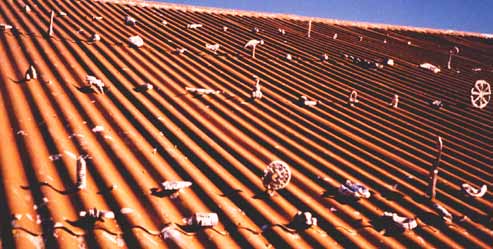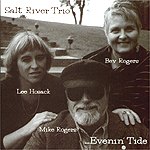Currently only excerpts & illustrations from the last 13 issues
(numbers 43 to 55) are on this site.
Scroll down to view the February 2001 issue. Click on the numbers to view other issues.
Info about the current book on the arts
|
 |  |
 A listing of the contents 1992 - 2002 >> (numbers 19 - 59)
A listing of the contents 1992 - 2002 >> (numbers 19 - 59) |
Contents List |
 |
excerpts & illustrations
(The full articles are only available in the printed magazine. Click on "subscribe" for more info.)
|
 "Rising (2)" "Rising (2)", 1998 painting by Dave Taylor, U.S.A.
|
number 54
February 2001
News & Letters
page 2
Orison VIII
Orison, the arts journal of the Bahá´í Institute for the Arts, a special interest section of the Association for Bahá’í Studies, North America, is now available in its eighth issue, with the theme,
"Invoking the Light / Knowing the Water".
This elegant 50 page publication of poems, articles and artist
profiles, can ordered for US $9 from Anne Gordon Perry, 702 Keywe Place, Duncanville, TX 75243, U.S.A. More info: unity9@earthlink.net unity9@earthlink.net
|
Letter from
, Russia.
 We just finished the setting for a puppet theatre in the small town of Rybinsk. The play was based on a Russian folk tale, and we wanted to give it a sense of spirit which took a lot of work with the director. Before that we worked on the Puskin Project for an outdoor stage in a square near the Kremlin. The director there was a joy to work with for this 5 hour show. We made large puppet heads which the actors wore (one was 168 cm in length) along with statue-like constructions. The performance was a mixture of theatre and a game which involved the public.
We just finished the setting for a puppet theatre in the small town of Rybinsk. The play was based on a Russian folk tale, and we wanted to give it a sense of spirit which took a lot of work with the director. Before that we worked on the Puskin Project for an outdoor stage in a square near the Kremlin. The director there was a joy to work with for this 5 hour show. We made large puppet heads which the actors wore (one was 168 cm in length) along with statue-like constructions. The performance was a mixture of theatre and a game which involved the public.
I have joined the Union of Moscow Artists (in the area of theatre, film and television) and now am able to participate in their exhibitions and to hopefully get a studio one day. It is important to me because this means I am able to have more contact with other artists. Here being a member of this artist Union is sign professionality. After that my husband Peter and I exhibited 42 paintings in the Intercolor Gallery here in Moscow. We included 5 watercolours by one of our young students as well to relate a child’s work to our own. The reviews and experience have been very helpful for us to see our work with some distance. At the same time I took part in a project called “White Town” an exhibition of the work of young actors, singers, theatre and video-artists. Here I showed 4 studies for theatre and a section of photographs.
|
Artist Profile:
pages 2 - 6 , sculptor, Aotearoa / New Zealand
|
 Jeff Thomson Jeff Thomson, 2000
Photograph by Sonja van Kerkhoff
The Netherlands. |
In 1977 I went straight from school to studying painting and printmaking at Elam, the school of Fine Arts in Auckland. It was a four-year degree, and after three years I took a year off and spent a lot of time hitchhiking mostly in the South Island.
Not getting a lot of rides, I ended up doing a lot of walking and through that became aware of and interested in roadside paraphernalia such as roadside advertising, fence posts, squashed animals and letterboxes.
I decided to take a long walk, on which I would put a letter into every letterbox proposing that I make some kind of alteration in the form of an advertisement for the letterbox.
|
The first walk in 1981 was a five-day one from Bulls to New Plymouth, about 250 km along the west side of the North Island. For this project, I made several small cut-out shapes of livestock out of plywood, which I attached to the mailboxes. On another walk, I picked up a sheet of rusty, red corrugated roofing iron and made a small cow out of it, which sat on top of a mailbox.
Someone driving past stopped, found out who made it, and commissioned a series of life-size wildlife animals made out of corrugated iron. They wanted a tiger, penguin and elephant.
|
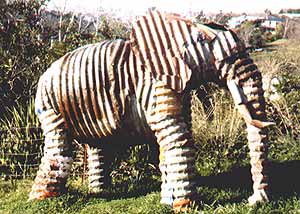 Elephant Elephant, 1988, by Jeff Thomson. |
Someone who saw the elephant commissioned a fence of elephants for their garden boundary. They’d had a dispute with the neighbours about the boundary fence and commissioned the elephants to sit with their backsides facing the neighbours. This work got a lot of publicity in the art world, appearing on television and in the national art magazine. All of a sudden and over the next few years, I got many commissions for tin animals for people’s homes, and it developed into a full-time business.
|
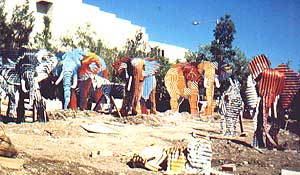 Menagerie for the Brisbane World Expo, 1988, by Jeff Thomson. |
Corrugated iron was introduced in Australia and New Zealand during the 1860s for housing on the gold fields and is an integral part of the New Zealand psyche. Twenty years on, I’m still getting many commissions from around the world. At the moment I’m working on a herd of 30 life-size cows for clients in Sydney.
The work is very much a commercial enterprise that flows into the art world. It funds my more experimental projects, which cover the whole gamut from works for art museums to remote sites. |
Some projects I’ve done include making a life-size wildlife menagerie out of reused corrugated iron in 1988 for the World Expo site in Brisbane.
The work is very much a commercial enterprise that flows into the art world. It funds my more experimental projects, which cover the whole gamut from works for art museums to remote sites. Some projects I’ve done include making a life-size wildlife menagerie out of reused corrugated iron in 1988 for the World Expo site in Brisbane.
While making the commissions, I explored working with corrugated iron in a variety of ways, such as stacking, curving, cutting into strips and weaving, cutting into the surface to create lacelike effects, silk screening images onto surfaces, using industrial processes such as rotational plastic moulding (to make unusual shapes), and powder coating (a way of baking protective colour onto the iron surface).
|
 Pirouete Suite, 1994, by Jeff Thomson, in the Dowse Gallery, New Zealand. The show was on the theme of windvanes.
Each piece moved in the wind.
| Currently I exhibit several times a year in New Zealand, Australia and Germany. Often these are solo shows involving working on location, where the show becomes an installation space involving various pieces. In these shows the work tends towards the abstract.
While collecting perforated metal such as wire netting from rubbish tips, I realised that I could make my own perforations in the metal by using oxy/acetylene and plasma cutting (which gives a very fine clean cut). I liked the way the physicality of the material was transformed physically and psychologically. The metal looks lace-like and is no longer weatherproofing material. I also collected printed petrol, olive oil and paint tins. These led me to begin silk screening onto flat sheet steel, which I then shaped using various
machines... |
Artist Profile:
pages 6 - 8
The Salt River Trio, Lee Hosack, Bev and Mike Rogers,
musicians, singers, songwriters, U.S.A.
|
|
 The Salt River Trio The Salt River Trio, Lee Hosack, Bev and Mike Rogers, performing in Kennebunk, Maine, 2000. |
Mike: I began playing professionally in 1970 with New Hampshire poet/songwriter John Perrault. John and I recorded five albums from 1976 to 1999 and we are still a happy duo today. We opened for Emmy Lou Harris, The Eagles, Mountain, Tom Rush and Jonathan Edwards. My music genre has always been acoustic folk, blues and gospel, along with jug (skiffle) band music of the 20’s and 30’s. I began writing my own material and playing
guitar when I became a Bahá'í in the early 80’s...
I taught in the public school system in Maine until 1978, when I lost my sight due to retinitis pigmentosa. This was a blessing in disguise as I was able to turn my attention to being a full-time musician. |
We left Maine to pioneer in the Bahamas in 1984 and Bev began singing with me at that time. We were after all, alone on a tropical island...
...Bev worked as the sound technician for various groups over the years as well as in the recording studio for our recordings. She has an excellent ear for the process of recording and mixing. Bev started singing with me in 1984 and she added an excellent alto harmony. Her years as a children’s storyteller provides animation and enthusiasm to our performances. Bev and I have worked with VSA arts (Very Special Arts, International ) in schools and institutions since 1989. This agency brings artists with disabilities into schools, etc. and exposes students with disabilities to the
arts...
Presently, Bev and I live in Eliot, Maine (near the Green Acre Bahá´í School) and I have pursued by interest in writing poetry. And to my amazement I received an award from the New England Writers Association which was published in their 2000
Anthology...
We met Lee Hosack at Green Acre Bahá'í School in 1984 and have been good friends ever since. Upon our return to Maine in 1998 we joined forces to form the Salt River Trio. Lee sings, plays guitar and writes songs, something she has done since the age of sixteen. She has been performing professionally since the early 70’s. She performed for many years as part of a duo with her husband Larry, for weddings, receptions and other events including schools and children’s festivals.
Currently besides being the third member of Salt River Trio, Lee is also a member of “Windstrum”, a semi-classical, traditional and Celtic folk trio. Two of Lee’s songs were included in the children’s cassette “Sing This Melody” produced by Images International
in 1977...
The Salt River Trio has just released it’s first CD “Evenin’ Tide”. This one hour CD features original songs
including three cuts appropriate for use at Bahá'í Feasts: "O Son Of Spirit", "The Remover of Difficulties" and the
"Healing Prayer". It contains strong vocal harmonies woven throughout with acoustic guitars and harmonica.
It is available through the Bahá'í Distribution Service, 4703 Fulton Industrial Boulevard in Atlanta,
Georgia 30336-2017, USA., tel: 1-800-999-9019, email bds@usbnc.org. The cost of the CD is $15.00 plus $5.00(US) minimum shipping charge. The trio's style has been described as "folk music in the purest sense" by Face Magazine, Portland, Maine, USA. This style is evident in the title song "Salt River", a song written by all three members on a chilly March afternoon. The lyrics portray the four seasons on the shores of the Piscataqua River (third fastest tidal river in the world, and it divides
Maine and New Hampshire).
...The lyrics to "Netting Song" were written by Cheryl Cudmore from Prince Edward Island, Canada. This song describes the fishing life of her family.
|
"With shuttles and fingers we hitch-knot each row.
A net made of diamonds for traps that lay low.
James serves us biscuits, molasses and tea
And plays us his fiddle singing Drowsy Maggie.
Late when the sun sets, our oil lamps we light
And work at our netting well into the night.
We'll rise up at daybreak, return to out toil
Until our work's finished, not a second to spoil.
Soon will young Duncan plow off through the seas
Aboard his fine vessel to gather bounties.
And Anna our sister will watch at her door
For Duncan and Hester returning to shore."
|
|
...The trio is on the road continually and starting the creative process of our next CD. You can contact them about gigs or CD sales at: saltriver@mediaone.net or phone: 207 439 4995. |
Artist Profile:
page 9 ,
sculptor, Aotearoa / New Zealand
|
|
I’ve been carving stone for the last 4 years and I started doing this intuitively when I was in the bush for a time. I made an axe and just starting carving with river stone I found and it just has gone on from there. I start with just playing with the form of a rock or stone adn then ideas or shapes come from that. I like the idea of changing something that seems impossible or hard to change such as rock, and this reflects my attitude to life.
That we can always change and nothing is impossible....
I am based in rural Taranaki in an old factory and I usually work when it is warm enough to work outside.
|
I use hand tools about 80% of the time and diamond cutters the rest of the time. I tend to sell my work at stone carving symposia and only need to sell a few big pieces a year in order to have enough to live from...
...carving is a life-time thing and something of the spirit, not something you can pay for by the hour.
Sometimes my work goes to museums and sometimes to rural areas. For example, one piece was bought by the Te Papa museum (New Zealand National Museum) as a guardian stone for any future remains of Maori bodies. Previously I’d traded some of my sculpture with a few American museums to get some preserved Maori tattooed heads back to our
people... |
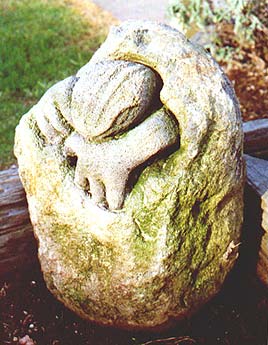 Stone Sculpture
Stone Sculpture, by Reece Rongonui
New Zealand. |
Artist Profile:
pages 10 - 13 ,
singers, songwriters, musicians, U.K.
|
 Geoff And Micheala Smith |
Michaela: I began writing some pretty embarrassing songs when I was about 16, most of which I cannot recall now...
I began writing in earnest when Geoff and I began playing in bands together from 1981 onwards. The material then was more jazzy and funky, reflecting my need to compose upbeat music to impress the others in the band with my musical prowess and get the audience’s attention. The lyrics were the usual love-song variety, with the occasional social or environmental comment. When I became a Bahá'í, I suddenly had so much to write about and was inspired like others to set the Writings to music. My best-known song was my first one,
which was written in 1987 and is called “One People, One Planet”. It is a very simple children’s song with hand actions. I’ve performed this song hundreds of times in all sorts of venues.
I’ve always been fascinated by chord structures and sequences in other people’s songs and have tried to utilise as many interesting chords as I could. At the time, lyrics were usually secondary to the music, but now I’ve become very concerned about the quality of the lyrics and will spend hours agonising over the right word...
|
In the past, the songwriter was the transmitter of news and wisdom to communities that were dependent on oral transmission, there being no media and little literacy. Nowadays there are still great songwriters who have brought the problems of the world to the attention of ordinary people through song. This is why song is so important for promoting the teachings of the Bahá'í faith. We often incorporate some of Bahá’u’lláh’s words and it is wonderful to see people from all walks of life singing along with
us...
|
“I Believe In You” is a significant song for me because it describes how I became a Bahá'í as a result of a dream. I dreamt I was held in a huge hand curled up in the foetal position and the message of the dream was that everything would be all right. Really, this was the atheist being told it was all right to believe in God and given confirmation that I was loved and protected by my Creator.
Geoff: We’re both musicians and singers, though my vocals are usually used as backing or harmony vocals.
|
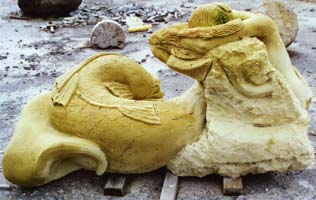
Mermaid sculpture in progress, 2000, by Reece Rongonui, New Zealand / Aotearoa
|
Michaela plays a lot of the guitar on our latest CD. We collaborated on the arrangements of the songs, often improvising on the songs for long periods, which helped with the arrangements. I tend to liken the recording process to sculpture. You start with a solid mass of material, which is the recording of the song consisting of many parts. Repeated listening allows you to pare away some of the superfluous sound to reveal the structure of the song underneath and this could be likened to how a sculptor gradually finds the shape of the sculpture by cutting away the stone that isn’t required. My input is in engineering and mixing the tracks and trying to support her songs with sympathetic playing. The instrumentals are written by me.
The song “Dreamtime” was written in response to several themes.
One was Bruce Chatwin’s The Songlines, which is a description of the aboriginal songlines and mythology about the Dreamtime, hence some of the lyrics such as:
|
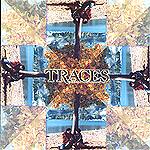
Cover of Traces, music CD by Geoff and Michaela Smith, 1999 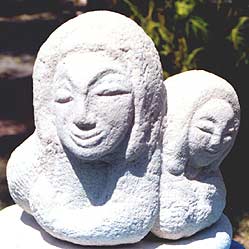 Mother and child
Mother and child, by J.J. Jannu, Australia.
|
Where Lizard Man named the cave and the waterhole
Spinning out the songlines
An ancient voice sung the world into existence
The same spirit moved the dream.
Spinning out the Songlines
An ancient voice sung the world into existence
The same spirit moved the dream
But I've heard a strange bird calling
bringing sweetness to my soul
I've learned melodies on the breeze
Of a greater alchemy
Than base metal into gold
You walk in the foothills of the ancestors
Every step on sacred ground
You talk of the spiritual landscape
And wrestle with your needs and doubts
A chosen path that severed my connection
Left no fruit upon the tree
But I've heard a strange bird calling...
Originally from Hyderabad, Southern India, Jannu has being carving in wood and stone for many years. He adopts a prayerful attitude before and during the sculpting process. The Bahá'í teachings inform most of his work. The work here is inspired by the praise of motherhood.
|
Excerpts from an interview with Sonja van Kerkhoff, 2000
Geoff: The reviewer’s reference to “music can signify beyond itself, that it can be deconstructed in a multitude of ways, read as a social (rather than autonomous) text, and exist as a discourse of signs.” leads me to mention Derrida because the whole philosophy of deconstruction has been largely discredited as the birthplace of political correctness and of having grown out of a milieu of political ideas that includes fascism. Postmodern critic, Thomas Oden notes:
“Deconstructionism...[is] always asking the skeptical question about the text, asking what self-deception or bad faith might be unconsciously motivating a
particular conceptuality.”
Can it be that Bahá'í`s with a sophisticated intellectual frame of reference are afraid of the `inarticulate speech of the heart` to quote Van Morrison. Sonja you mention your preference for songs that are `complex` in their associations and I too have looked for this complexity but at some point I asked myself ‘is it not restricting to go to music with these prerequisites?’ I look for what moves me and this allows me to respond to music as as simple and emotional as Willie Nelson or Emmylou Harris`s `Wrecking Ball` and music as complex as John Coltrane and John Adams. I have come to suspect that my need for complexity is part of our modern disease. (By the way I went of complexity when I heard Maria Carey refer to herself as complex -I mean everyone`s doing it!)
Of course like you I also respond to complexity when I feel that it has been sincerely arrived at. But I don`t believe you can just be complex. Lyrically I believe that you have to understand what it is that you are saying before you can communicate it to others. Although I am of course aware that music will also communicate on subconscious levels.I am sure that many people will point out the validity of stream of consciousness type lyrics and poetry and Paul Simon argues that lyric writers needn`t be so literal but for me personally I`ve come to appreciate the succint and the razor sharp lyric. I like protest and political song writing as well as songs that educate and inform a wonderful example which I would like to mention is `Muir and the Master Builder` on Dick Gaughan`s “Redwood Cathedral”, C.D [ Greentrax 158 ]. Of course it probably all boils down to personal taste doesn’t it. This is the music that interests and moves me now....
I like what the comedian Billy Connoly said of the simplicity of life being that `you`re born you fall in love, you look after those around you and the planet, then you die and it’s someone elses turn ` The Bahá'í Faith –it`s a simple message isn`t it...
...On a lighthearted note aren`t the lyrics to “Dreamtime” which refers to Quantumn mechanics; the Aboriginal Dream time; the symbology of Alchemy; and “a strange Bird calling” (a reference to Bahá`u`lláh) complex enough for ya? Perhaps we should throw in some semiotics or a reference to Roland Barthes `Camera Lucida` what do you think? (I am joking)
Final thought - in the face of the increasing souless complexity of life we strive to produce art that is soulful and simple. I think of our music as simple but with depth -I want it to become simpler and deeper-
About the stories in our music. Michaela writes to her muse and she can`t write when it`s not there.
Stories (myths) have been extremely important in all revelations and in our faith we have `The Seven Valleys`
in which I believe Baha`u`llah has presented us with those stories, myths and fragments which he deems to have relevance to our time. Some of our work tries to respond to what Bahá`u`lláh has said, done or indicated we should meditate upon. I am of the opinion that the work of Bahá'í artists of the future will be transformed by the challenge of responding to the Bahá'í writings just as artists have produced so much that is transcendent in response to the sacred texts of their cultures. Much art of the past was produced in response to sacred texts illuminating the texts, painting scenes from the texts visual symbolical imagery, Christian and Islamic sacred architecture and non representational islamic art. The same goes for music. I believe that the U.S. writer Tom Wolfe`s point about Abstract Expressionists being the mouthpiece of art critics still applies because art is still reacting to the death of religion or the death of meaning/god/whatever. But as Bahá'ís we have this whole new transmission of sacred text to work with and so I think we will have to deal once again with the whole notion of music relating to the text as a means for telling stories in new ways rather than music or art which is just an expression of the artists own response. It’s interesting that God still chooses the word to convey his meaning to us even if the meaning is not always literal. Whatever your art form there is an underlying theory or way in which you work. A lot of conceptual art can be paraphrased or its meaning conveyed by words, so, if at the end of the day we are still painting words or responding to them then we may wish to go back to the word of God. How we do that is another matter....
Artist Profile:
pages 13 - 15 , painter, U.S.A.
|

Dave Taylor with his daughter, 1999 |
I make oil paintings on canvas and paper in sizes from very small to about six feet by five. I try to surprise myself and please viewers who have a commitment to the visual and a grounding in the culture of Western painting as it has developed to the present. I make no apologies about making work for cultured viewers. In fact, my paintings are usually fairly accessible to unsophisticated viewers, but the viewers I have in mind when I make them love painting and spend a lot of time looking at it.
|
My primary commitment as an artist is to painting. I also make drawings with graphite on large sheets of paper. I like to see what I can do with simple media, wrestling with spaces made of marks. My imagery is also simple, although it may pile up in dense accumulations and deliberately courts several kinds of ambiguity. I like suggestion. I like to see one thing become another. I get a lot from free association and memory as well as direct observation.
Every mark, every configuration, every object is haunted by a rich past. Piero Della Francesca, Goya, Valazquez, Titian, Rembrandt, Manet, Cezanne, Soutine, Matisse, Picasso, Gorky, Willem De Kooning, Philip Guston, Max Beckman - there are many others that I look at and remember, and are important to me. These painters exemplify for me the range and the depth of Western Painting.
|
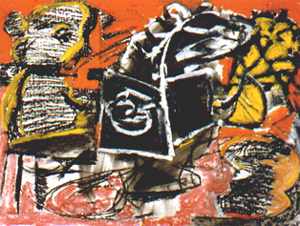 Jack on the box
Jack on the box, oil stick and charcoal, 1993, by Dave Taylor |
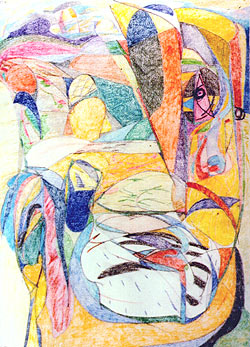 Rising (22)
Rising (22), 1999, pencil on paper, by Dave Taylor |
In art school a friend said to me, “What do you need religion for? You’re a painter!” He meant that painting is itself a religion.
For the last few years I have been living with ghosts. Works in the “Rising” series of paintings present a single figure, with body embedded in the earth but head pulling free and radiating upward, eyes wide and staring, a ghost rising up. Arms may be vestigial or not be present at all. The body is often a circle, often divided in half with a red or grey heart. |
Feet are frequently sticking up, sometimes with clunky shoes and pants. There is a landscape, often but not always desolate, and some kind of grave marker which may resemble a stone or a pyramid or sometimes a bell (although the head is itself reminiscent of a tombstone).
For me this is our everyday experience of upheaval and partial awakening in wonder and embarrassment. It is a celebration of mystery in modern life. It is also a picture of conflict between body and soul, of vulnerability and humiliation and yearning and fear.
The transformations my figures experience are the transformations I am going through myself and the transformations I see going on all around. The ghost image of “Rising” carries for me associations of isolation and bewilderment in an existential situation on the one hand and participation in “the Last Judgement” on the other.
| 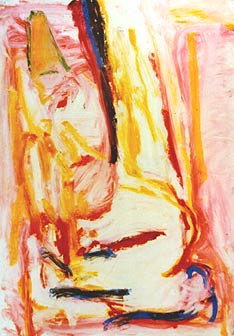 Rising (23) Rising (23), 42 x 30", 1998 by Dave Taylor |
 "Rising (2)" "Rising (2)", 1998, oil on canvas, by Dave Taylor
|
The degree of abstraction in the image and the variations it allows give me a range of expressive choices that allow me to say what is important and leave obscure what I want to be obscure. The work is about struggle, about the creative tension that comes with confusion and awkwardness and embarrassment. The work is about facing death. The work is tremendously personal. Too intimate to speak about openly without distortion.
Painting is for me a beautiful way to make my confessions and at the same time keep my secrets. Paint suggests. It does not declare. In a painting nothing is fact but everything is analogy. Faith is there, and everything that is difficult about faith is there also.
I see sex and death and rebirth embedded ambiguously in everyday life as shadow presences. They demand an abstract and elusive treatment but also a kind of familiarity -a mixture of awe and low comedy. That’s what I go for. I try to avoid too much sweetness. |
I am interested in the spirituality that lurks in flesh and blood. As I pursue these images, other images begin to approach. Paths open. Lately I have been thinking about going to the shopping mall to draw. Maybe that is why I like oil paint so much. Maybe that is why I like semi-abstract art.
My primary commitment as an artist is to painting. I also make drawings with graphite on large sheets of paper. I like to see what I can do with simple media, wrestling with spaces made of marks. My imagery is also simple, although it may pile up in dense accumulations and deliberately courts several kinds of ambiguity. I like suggestion. I like to see one thing become another. I get a lot from free association and memory as well as direct observation... |
...Appreciating Tobey’s gentle textures, his quiet “art informel.” I saw also that his way was not mine. I knew I would have to start over. I would not be looking to the East but to the West.
I went to the Maryland Institute College of Art to pursue objects and figures in space. Three years of art school in Baltimore and two in New York, at the New York Studio School gave me more than a BFA and some technique. It gave me an immersion in a rich if wandering culture, a living conversation that has roots in the workshops of renaissance Italy and the cafes and salons of 19th and 20th Century Paris and the all-night cafeterias and studios and bars of New York. I experienced modern life with its stress and paradox and ferocious beauty...
All this time I have been looking at the work of Bahá'ís who are artists and reading what Bahá'ís write and joining in the art talk. Being part of this community I try to make myself useful. Sometimes I lean against the prevailing winds. I don’t set out to be difficult. I just want to make the sort of work I like, the paintings I want to see. I don’t try to make “universal” art. I look to the West. |
 Rising (5) , 1998, oii on canvas by Dave Taylor |
I call attention when I can to the beauty and the spirit lurking in Expressionist art, in Surrealism, in Pop, in the less idealizing Abstract Expressionists, such as Willem De Kooning and Franz Kline and Jackson Pollock. I don’t see myself as a visionary working in isolation. I see myself as part of a continuing culture.
|
Artist Profile: pages 16 - 19
Yang Gang, painter, teacher, P.R.China.
|
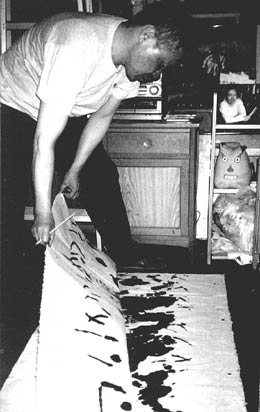 Yang Gang working in his studio,1998. Photo: Liz Coats, New Zealand. |
Notes from China
Part 1: Yang Gang - ‘The Great Wide Open’
In 1998 I had the opportunity to work for four months at the Beijing Art Academy in China on an Australian Asialink-sponsored residency. The painter, Yang Gang chose to be my tutor during the residency and his studio was near mine. We had no language in common, but as time passed empathy grew between us around the work we were both separately doing.
The Beijing Art Academy was established in the 1950’s to support prominent Chinese painters in their full-time studio practice and, from the Government’s point of view, to protect and influence continuity in Chinese culture. The artists have a studio and apartment in the compound and a pension for life. While the Academy supports professional artists, scholarship students from all over China are given tuition in traditional paintings methods on a one-to-one basis.
|
...My tutor, Yang Gang, was deeply affected by an experience of living and working with nomadic people in Inner Mongolia during the political upheavals of the 1970’s, when his initial painting studies were interrupted by the Cultural Revolution. The notebooks of sketches he made at that time are now a source for many of his paintings and he calls himself a ‘Grasslands’ artist. He also experiments with western influences in paintings on paper, and oils on canvas, but with his own bold independence...
Yang Gang often worked on the floor, carefully positioning a sheet of paper so that his body movements in the cramped space of the studio could follow the intended momentum of an image. I watched him make a densely-minimal and almost calligraphic painting of Mongolian herdsmen rounding up horses. I saw how intangible elements in light could be made visible in the shifting configurations of black ink and water bleeding into light-toned, absorbent paper. What you saw were images within images, coming close to natural chaos at one minute, then re-forming into composite shapes with a few more carefully placed marks. These paintings can be added to but can’t be corrected. They are tough and delicate, with a beginning, a middle and an end.
Lively images that are essentialised out of complex forms need transparency, and an
unbalanced brush-load could result in the whole thing ending up in the pile of crumpled paper in the corner...
|
 Setting Out Setting Out, ink on paper, 1999, Yang Gang. |
On another occasion... ...Yang Gang moved around the image in his socks, mapping out major compositional weights and shapes. Relationships kept changing as he balanced and re-balanced tonal contrasts and modulations in dilute and partial overlays, as if climbing and gazing on those cliffs again. Where and how many additions were made to a particular area seemed to be qualified by the pattern of body movements across the paper as well as visual assesssment.
Because the workspace was so contained, he appeared to rely on experience and prediction to build shapes, until the whole could be pinned up for viewing.
There was a sense of contained drama throughout a painting session and right up to the addition of seal, signature and date.
Making strong and vigorous paintings like these demands an ability to hold concentration. One must stay with the impulse and not break concentration while interpretative shifts are made intelligible. |
Images arise out of combinations of events. Brushmarks were all abstract in one sense, with many fragments leading to essentially figurative outcomes, while observation and method were held in balance and adjustment at every moment. Working with the simple delicacy of this medium calls for restraint, while the nature of the activity alludes tothe grace of qualities, ungraspable...
|
...He showed a selection of ink on paper and oil paintings at Creation Gallery in Beijing in June, 1998. Many of these paintings were experimental portraits with psychological intent and he called the exhibition,
My Island of Resurrection. In his exhibition statement he wrote:(translated from Chinese)
“Face” is a cultural symbol. It was well known in ancient times. For instance, the ancient bronze totem, Taotie (a mystical, ferocious animal); Nuo (exorcise); and different kinds of masks including all types of facial make-up in Beijing Opera. These faces are the beast face, the wry face and the god face of the creators. All the faces have been created out of fear, admiration, search, chase or maybe humour. So, the face totem symbol appeared in my artwork. In the beginning I drew faces without any deep meaning, later I drew more and more carefully. Finally my drawing achieved a deep emotional
meaning...
| 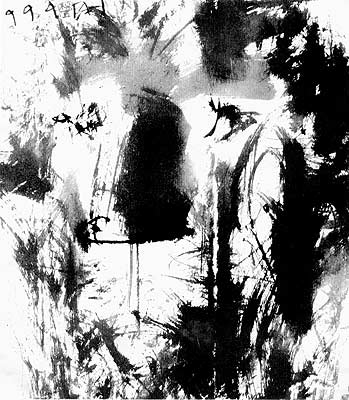 Portrait of a Lion Portrait of a Lion, ink on paper, 1999 by Yang Gang. |
Part 2: The Sieve, nets and everything
In the catalogue statement for my exhibition of paintings, The Sieve, Nets and Everything at Creation Gallery in Beijing in June 1998, I responded to cross-cultural meetings as follows:
“I understand for artists, making room for our ancestors to speak to us through the work, does not necessarily mean our own family, because we all belong to a larger framework. I think you learn a lot by observing natural phenomena everywhere, for instance in nature, where living patterns are not disturbed. You can apply this knowledge to painting. This is really a very simple idea. So that style is not an issue and you do not need to work hard to challenge tradition; you are already in the tradition of ‘seeing’. You have to keep working, not only because you want to keep learning, but because you should not let go of the net that you are
creating.”
My area of concern in painting is an objectified or reconfigured space in-between, which I present as geometric structures becoming animate. I have also described this as playing with formality and coincidence.
|
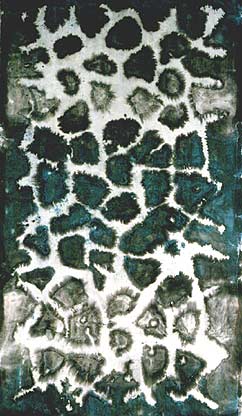 Net #4 from the “Sieve, Nets and Everything” series Net #4 from the “Sieve, Nets and Everything” series, ink, pigments, and gesso on Chinese paper mounted on silk, 94 x 55 cm, 1998, by Liz Coats, Australia / New Zealand. |
In a talk to students at the Beijing Art Academy I explained that, while I don’t have the drawing skills of a Chinese artist, I look for the pivot and balance in things through other means, like working from the inside out. So the surface - the skin - becomes the result of what happens underneath. I now consciously work from the underside to make an image. I call it building structures. As those structures grow and connect, a cohesive image may emerge. I do not start with a complete image, a picture that I can visualise, but an interest in recording the way we see and know dimensionality, and how shapes and lines can connect with transparent colours to make a painting come alive.
Originally I had no intention of developing a full body of work in Beijing in the short period of four months that I was there. I hoped that by being responsive to daily events and staying open to chance (ouran), I might meet in an uncontrived fashion with something of the flavour of that environment. I was not prepared to be an obedient student, attempting to gain a facility with ink and brush painting in the Chinese manner, so I worked at a tangent, seeking an empathy with local materials and some of my own ingredients.
I decided it would be sensible to work on paper and it was natural to work with water, as this is the most characteristic element of traditional Chinese painting. I was impressed by the sensitivity and strength of Chinese papers and did not want to override this. |
After six weeks’ experimenting with various media, a result was there quite clearly and I was pleased when Yang Gang came into the studio with his thumbs up...
I had chosen a geometric format from a lattice window in a Chinese private garden compound, empathising with the over and under, hexagonal arrangement and purpose of this structure as a divider and mixer of light in-between.
I watched the pigments brought from Australia and black Chinese ink spreading through gessoed paper. By brushing aqueous colour stains onto the back of a painting, bleeds, cracks and hard edges of colour showed against and through an applied resist, drying into stable forms. These lattice geometries embedded in the gesso ground were inherently formal, yet visually highly active on the top side...
I had been reading a Chinese anthology of poetry, the Book of Songs, when I encountered reference to star constellations connecting with social conditions on earth. During the first week in Beijing I was reading a 2,000 year old poem referring to times when the Sieve stars open wide their mouths, words can be deceptive and some invididuals are obliged to leave the centres of power. The Sieve stars can also be translated as the Winnowing Fan - a bamboo basket that women use to sift and separate husks from the grain. Somehow this naming of a group of stars, The Sieve, touched me. Again, I found reference to a group of Net stars, which catch wild beasts or fish, but can also protect. These concepts still have an everyday life in China after thousands of years.
On a walking trip in the mountains with Academy artists, I noticed a tiny mesh shape hanging in a tree. As I reached up, an artist beckoned me not to touch it. Later in the studio I came to understand that this miniature wire and cotton-net utensil was a humble tea strainer. But it had rather more private and wishful meanings for its owner. Hanging in that peach tree, this simple utensil was taboo to anyone but the catcher and any invisible presence that might be attracted to it.
I discovered that much of the old Imperial architecture in Beijing and elsewhere was informed by linkages between heaven and earth, if you like. That the emperor was conceived as a conductor and transformer of the energies which keep the world upright and alive by the currents that passed through him. Once upon a time, the Heavenly Heart platform at the centre of the third tier of the Circular Mound Altar was recognised as the centre of the world. Only high officials could get within miles of this spot, and no-one but the emperor could stand there, after days of ceremony and purification. The Tiantan (Temple of Heaven) compound contains circular temples with crenellated, umbrella-like blue roofs. Their beautiful shape also describes a traditional, circular fishing-net with drawstring at the centre to pull tight.
I came to realise that the ‘emperor’ can be everyone and anyone outside of this context, as much as people identify with him. ‘Gang’ as in Yang Gang is the ‘emperor’ who pulls the drawstrings of the net; also, ‘a guiding principle’ and heaven knows what! These expansive concepts form wonderful metaphors in the context of art.
|
Poems
SCALLOWAY
The calm water reflects;
The fishing boat drifts;
Life’s moorings are
uncertain.
|
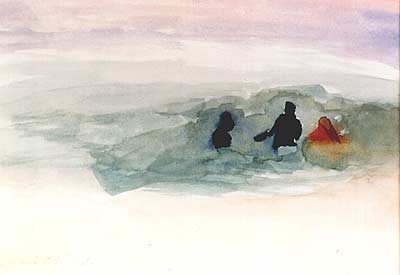
Beach Scene 1992, watercolour on paper,
Bonnie Fields, U.S.A.
|
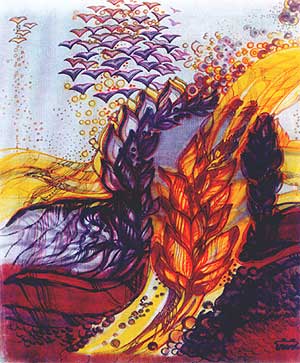 Belief I Belief I, painting by
Mária Titi, Hungary. |
Drowning in the Fire
I dream again-
my longing an aria da capo
that draws me back to the iron gates,
their pillared strength a dream-compass
homing me towards True North,
where a bone-deep urging calls to me
from that secret cave where the dark marrow grows-
speaking the Word that is only a sigh,
yet a wordless lover's plea:
my heart, in truth, the burning boat
that sinks in the blood-red sea,
drowning, at last, in the raging sky-
and buried whole in Thee.
|
The Swim
She goat-stepped over crags
to sanctuary, a stony beach
roundy for bare feet
with a necklace of squelchy seaweed.
The water was greeny clean,
delicious on her legs.
She dipped her fingers next
to bless herself against drowning,
then held her breath and dived
to the root of a shallow rock.
Delighted at the first body shock
she flipped her golden scaled tail
and floated in her grassy room
unreacheable, unseen.
There have been other swims
in other oceans, naked at midnight
and warm. There is only one womb.
From the Collection, “Where the Rocks Float”, 1993.
by Mary O’Malley, Ireland.
|
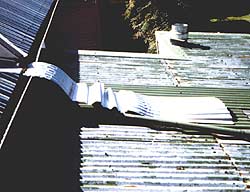 Roof Project in Wanganui Roof Project in Wanganui 2000. by Jeff Thomson, New Zealand.
"I solved the rain flow problems on one roof by creating a system of sheeting that created rapids to slow down and disperse the water flow. It has been interesting making these roof-related alterations in one small city, because they function more like one piece or a collection of works." |
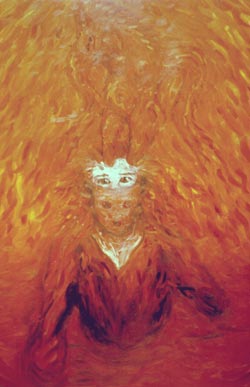 Rivers of the Moon Rivers of the Moon, 1985, by
Alexis Hunter, U.K.
...The culmination of this structural work
has come out as complex psychological
subjects painted in a simple, confident
manner with a tight formal structural base.
I have also kept the significant figure
centrally in the image to stand as a
symbollic icon as in religious art...
|
A Poem for Angela
In going on and on about our business
We choose the things that make us wholly us.
String and steel and love and hard-edged diamonds,
Chocolate, ink and bits of marble dust.
With these and more we build ourselves a person,
A boundless, endless, magic piece of art.
We make it with the things we lay our hands on.
We build us with the things we take to heart. . .
Pretending
I play a sacred game (some may think it sacreligious)
I pretend i’m writing ‘Abdu’l-Bahá’s correspondence
to the Friends i try to say what He would say.
I try to feel His way, and ways, to know all
like He knows, to write all, like He did.
But sometimes i’m Hafez,
dancing about like a fool on coals of fire
that warm me up dearly and tickle my souls.
And sometimes i’m Rumi with a head cold,
all stopped up and bold, everso boldy
sneezing out divine fragrances
and blowing my knows it all
at the students of soul.
And sometimes (it doesn’t happen much anymore)
i’m who i used to be, wondering how
i was ever so content with me.
Ashley Alvis, U.S.A. |
Article
pages 19 - 20
Water and light: two works by Bahá'í architect,
Fariburz Sahba, Canada, written by Eliza Rasiwala, Israel.
In recent years, many a visitor to New Delhi, the capital city of India, has come upon a white, lotus-shaped structure standing amidst vast gardens, on the outskirts of a busy commercial section of the city. This is the Bahá’í House of Worship of the Indian subcontinent, popularly known as the Lotus Temple, and often described as the "Taj Mahal of the 20th century". Inaugurated in December of 1986, the Bahá’í House of Worship in New Delhi is the latest in a chain of seven temples built by the followers of the Bahá’í Faith in different parts of the world. Its architect is Iranian born Fariburz Sahba, who is now a citizen of Canada.
|
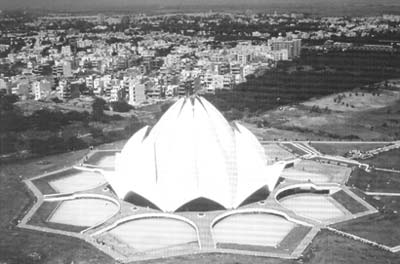 Photograph by Raghu Rei.
Read the whole article |
The architect conceived it as a lotus flower, a completely symmetrical form. But the choice of a design for the Bahá’í Temple was a difficult one, as he explains:
"On the one hand, a Bahá’í House of Worship should be designed to symbolize the freshness of the Bahá’í Faith, the world’s youngest religion. On the other hand, it should act as a constant reminder to the basic Bahá’í teaching that the spiritual essence of all the religions is one. Therefore the challenge before me was to prepare a design unique in form, nevertheless appealing to the aesthetic sense of people of different backgrounds."
|
Article
pages 20 - 23
Scripture as Literature: Sifting through the layers of the text: Part four
(continued from the last issue)
by Franklin Lewis, U.S.A.
There are parallels between the Hidden Words and the Qur’án, as well:
When we make men to taste of a blessing they rejoice at it, but if evil befalls them because of what
their own hands have wrought, then they despair. (Q30:36)
O Son of Man! Should prosperity befall thee, rejoice not, and should abasement come upon thee, grieve not, for both shall pass away and be no more. (HW, Arabic 52:) |
And finally, consider this hadîth qudsî:
...O My Servants! I have forbidden oppression to Myself and have made
it unlawful to you, therefore be not an oppressor one to another...
in light of this Persian Hidden Word (#64):
O Oppressors on Earth! Withdraw your hands from tyranny, for I have pledged Myself not to forgive any
man's injustice. This is My covenant which I have irrevocably decreed in the preserved tablet and sealed
it with my seal of glory.
|
  Beach Scene Beach Scene 1992, watercolour on paper, Bonnie Fields, U.S.A.
My mother brought me back a Chinese brush painting set from a visit she made to China
in 1985, and that was what first launched me into painting. These beach scenes were
made shortly after completing a life drawing course; at the sight of these &34;live" models
at a beach in Florida, I felt compelled to run and fetch my paints and give them a try!
|
  Zai-Fuzai Zai-Fuzai (Presence - Absence) 1992, Granite, located in a wooded headland near the village of Aio-cho, Yamaguchi Prefecture, Japan.
by Peter Randall-Page, U.K.
His works, inspired by the world of nature and celtic forms, exude a sense of a centred spiritual essence. Geometric
patternings play off each other in work such as Zai-Fuzai while in other works organic forms dominate.
See the February 2000 issue of Arts Dialogue for the article:
In mind of Botany about a series of works for an exhibition in the Royal Botanic Gardens in Kew, U.K.
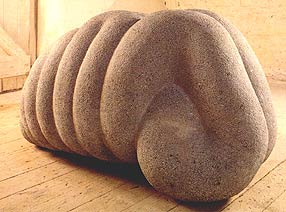 She-Bull She-Bull, 1995, Kilkenny limestone, by Peter Randall-Page, U.K. |
The Persian Hidden Words are even more intriguing than the Arabic from a literary point of view, in that they tend to be less proverbial and more esoteric, more firmly rooted in the later tradition of rhymed prose (saj` ), and frequently allude to well-known motifs and episodes from Persian poetry. Although perhaps the greater portion of his writings are in Arabic, it is primarily from the Persian literary tradition, as opposed to the religious literature of Arabic, that Bahá'u'lláh's writings draw their motifs and models
(with some exceptions, such as the Lawh-i Sultân )
His early Persian prose works should be read in the light of the Sufi literary tradition, particularly
as found (or at least as popularly received) in the major classical poets: `Attâr, Sa`di, Rumi and Hâfez, scattered lines of whose verse are quoted here and there in Bahá'u'lláh's epistolary works, especially Haft vâdi (Seven Valleys). There is surprisingly little stylistic influence from Bábí texts, though a good deal of terminology and doctrine come from those sources. Similarities with the philosophical and theological prose tradition, particularly the illuminationist school, which tended to blend literary and philosophical prose, can also be found. It should be further remembered that Persian poets and prose writers in the 19th century had rejected the ornateness of the Indian style (sabk-e hendi ) and had called for a return (bâz gasht ) to the models of the
11th-13th centuries.
Bahá'u'lláh's prose language in the Persian Hidden Words suggests the influence of Sa`di's Golestân and An âri's Monâjât; undoubtedly additional examples and parallels can be isolated. The themes and motifs, on the other hand, were those that had saturated later Persian literature, and could be
evoked by elliptical allusions that would resonate with and perhaps call to the reader's mind an elaborate series of associations, as in the first Persian Hidden Word, which reads almost like a catalog of classical motifs:
All Ye people that have minds to know and ears to hear: The first call of the Beloved is this:
O Mystic nightingale! Abide not but in the rose-garden of the spirit.
O Messenger of the Solomon of love! Seek thou no shelter except in the Sheba of the well-beloved, and O immortal phoenix! Dwell not save on the mount of faithfulness. Therein is thy habitation, if on the wings of the soul thou soarest to the realm of the infinite and seekest to attain
thy goal.
Excerpt with revisions from an article printed in
Bahá'í Studies Review volume 7, to be found at:
http://Bahá´í-library.org/bsr
|
Photographs and Illustrations of work by:
Alexis Hunter, U.K., Arleen Hartman, U.S.A.,
Jan Komarkowski & Margaret Hain, Aotearoa / New Zealand,
Peter Randall-Page, U.K., John Ranally Jr., U.S.A., Bruno Maximus, Finland / U.K.
Bonnie Fields, U.S.A., Ruhi Vargha, Raghu Rei,
Liz Coats, Aotearoa/New Zealand, Yang Gang, P.R. China,
Dave Taylor ,U.S.A.,
J.J. Jannu, Australia, Reece Rongonui, Aotearoa/New Zealand,
Sonja van Kerkhoff, The Netherlands, Mária Titi, Hungary, Kevin Bryant, U.S.A., Grant Langley, Michael Hajie, New Zealand, Jeff Thomson, Aotearoa/New Zealand & Elena Ostrer, Russia.
Translations, editing, co-ordination by:
|

Arts Dialogue, Dintel 20, NL 7333 MC, Apeldoorn, The Netherlands
http://Bahá´í-library.org/bafa email: bafa@bahai-library.com |
|




















































 Mother and child, by J.J. Jannu, Australia.
Mother and child, by J.J. Jannu, Australia.










 We just finished the setting for a puppet theatre in the small town of Rybinsk. The play was based on a Russian folk tale, and we wanted to give it a sense of spirit which took a lot of work with the director. Before that we worked on the Puskin Project for an outdoor stage in a square near the Kremlin. The director there was a joy to work with for this 5 hour show. We made large puppet heads which the actors wore (one was 168 cm in length) along with statue-like constructions. The performance was a mixture of theatre and a game which involved the public.
We just finished the setting for a puppet theatre in the small town of Rybinsk. The play was based on a Russian folk tale, and we wanted to give it a sense of spirit which took a lot of work with the director. Before that we worked on the Puskin Project for an outdoor stage in a square near the Kremlin. The director there was a joy to work with for this 5 hour show. We made large puppet heads which the actors wore (one was 168 cm in length) along with statue-like constructions. The performance was a mixture of theatre and a game which involved the public.

